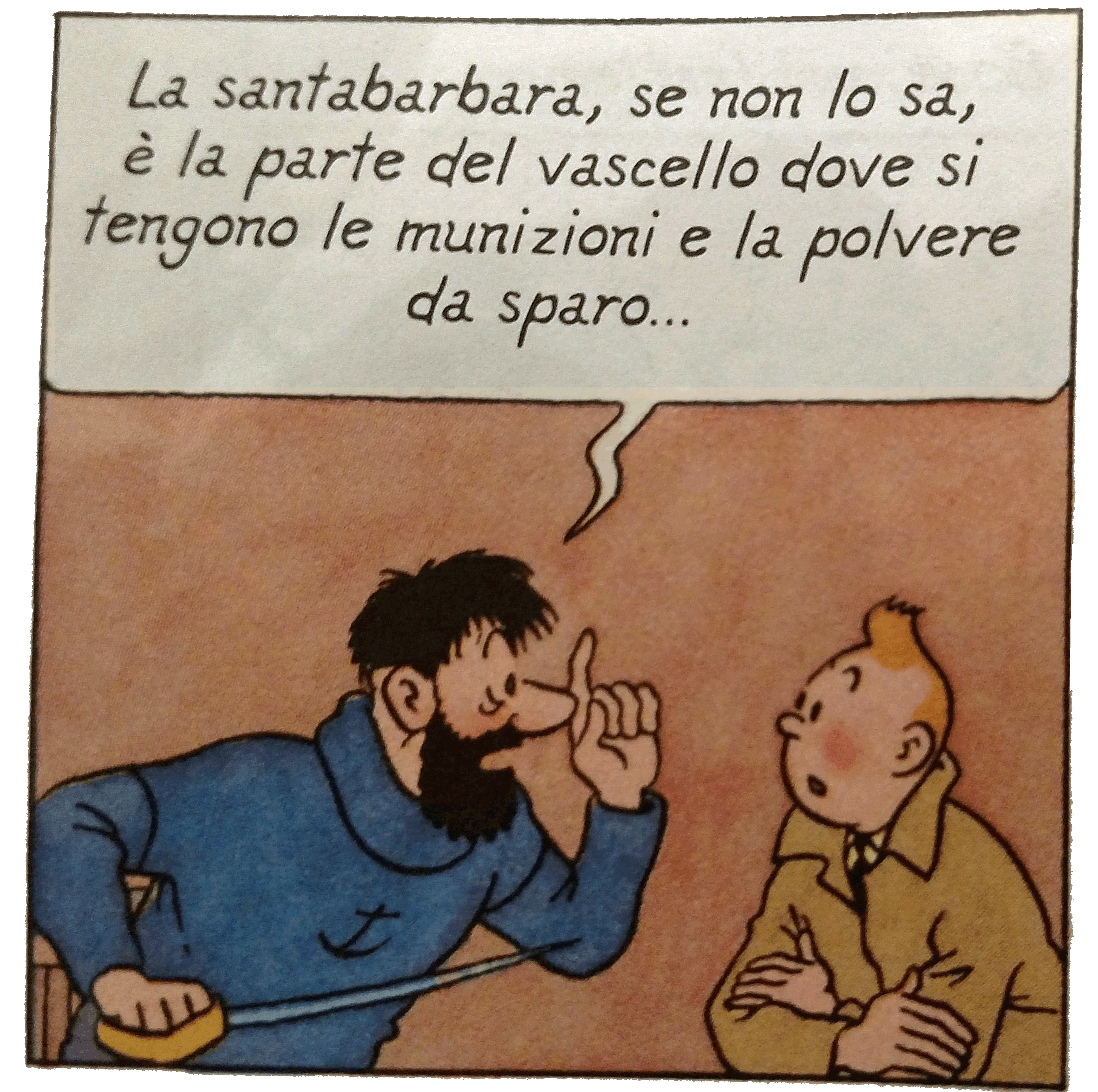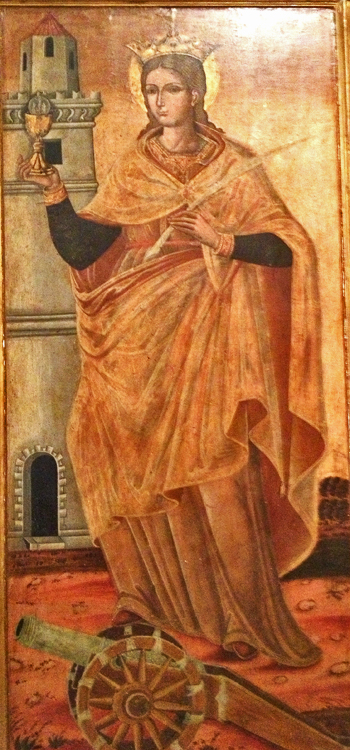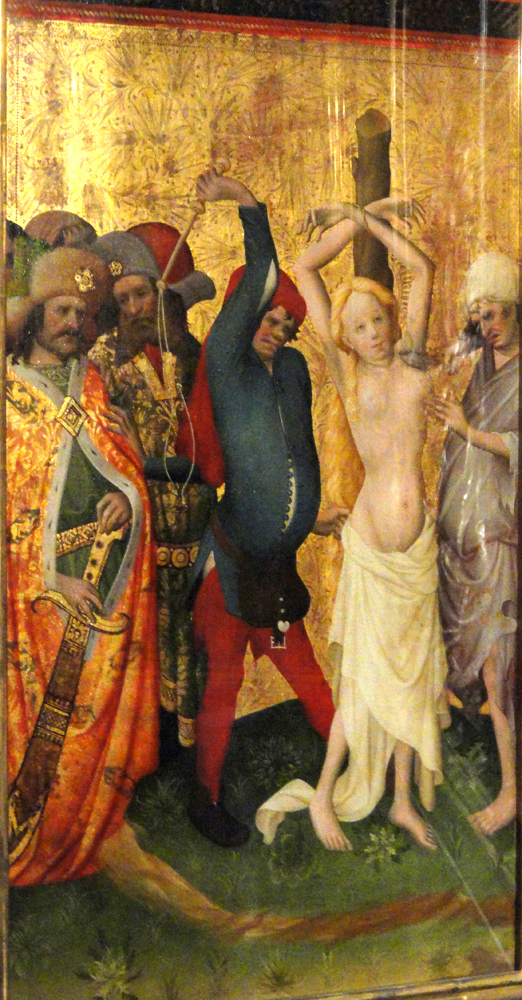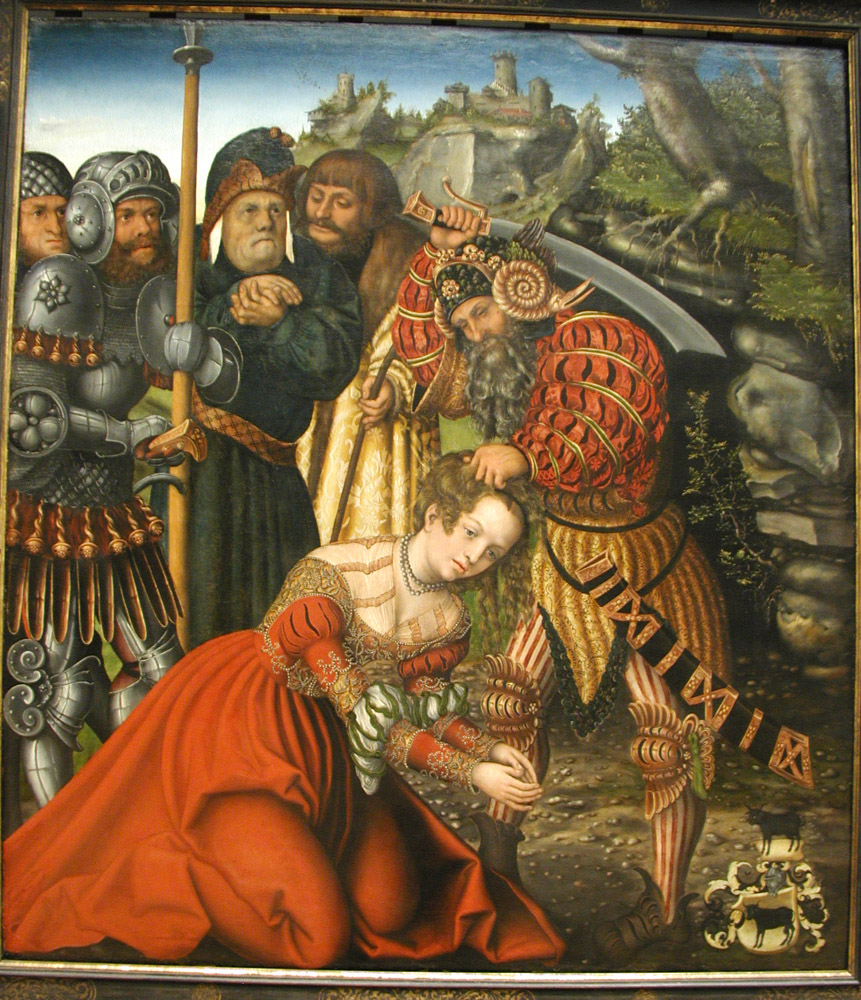After the sixteenth century ecclesiastical demand for St. Barbara images tapered off drastically.2 Thus most of the images on this page are from around the fifteenth and sixteenth centuries.
NARRATIVE IMAGES
Artworks from these centuries often present the story episodically in predellas (example) or altarpieces (example). Like the second picture at right, they are usually explicit about the nakedness involved in Barbara's tortures, a feature that did not survive the Tridentine reforms. In his influential elaboration of the decrees of Trent, John Molanus strongly condemned all "lascivious" images in churches and even in private homes.3 Clearly, images of a naked woman tortured and paraded through the streets fell under this stricture, and to my knowledge no more such images were created after Trent. We do see one Baroque-era statue in Pamplona of St. Barbara, or perhaps another female martyr, with the bodice folded back to show where her breast had been removed, but otherwise in sanctioned church art Barbara has only the slightest décolletage (example).
A further consideration may have worked against the story in both the art and the hagiography. Virgin-martyr stories are inherently anti-authoritarian. Young women take a stand against constituted authorities and often against their families as well. Some hagiography in the late middle ages sought to de-emphasize this challenge to authority by making the saint a dutiful daughter. In two late lives of St. Catherine, for example, her refusal to marry is carefully and respectfully discussed with her family.4 But Barbara's father is too unnatural for such a rewriting, so in an age terrified by rebelliousness there may have been no alternative for artists but to ignore the full form of the story and even avoid the story itself. At any rate, after Molanus there are fewer narrative images, and they focus on the beheading (example).
Caxton's "Life of St. Barbara" closes with a curious postscript about "a noble man called Valentine" who buried Barbara and her martyred companion Juliana "in a little town in which many miracles were showed." The miracles appear to be the point of this painting of the sick and the lame approaching a dead Barbara enshrined on a catafalque. (Juliana, a prominent figure in the 8th-century version, is completely absent from this and all other Western images.)
THE ATTRIBUTES
The Tower with Three Windows
St. Barbara's most common attribute is the tower with three windows, as in the 14th-century image at right and this one from the 15th. Sometimes the three windows will be in addition to others, as in the picture at right. Often they will be the only three (example). The tower is an easily recognizable image and a handy identifier in the many late- and post-medieval images that present an array of virgin martyrs (example) or arrange them around the Virgin and Child (example).
The Chalice and Host
In the century before the Counter-Reformation a second attribute was a chalice with a host, as at right and in this example. It symbolized the Last Rites The sacrament in which sick persons who are near death are anointed and given the Eucharist. In modern times it is called "The Sacrament of the Sick" and not reserved exclusively to those who are about to die. and referred to Barbara's final prayer for all those who "have memory of thy name and my passion, I pray thee that thou wilt not remember their sins." (Quoting from Caxton, but the second clause is exactly the same in John the Stylite.) But in 1576 Molanus condemned the chalice as a promise of cheap grace, citing a recent decree by the Council of Cambrai.5 After that, the chalice appears only rarely in sanctioned Catholic art (possible exception), although it is seen even today in unofficial items and in Orthodox and Anglican contexts (example).6
The Canon
A third attribute is a canon. Barbara is the patron saint of artillerymen, because the fire they visit on their targets is like the fire from above that ended the life of her father.
The Sword
Sometimes an image will picture Barbara with a sword, the instrument of her martyrdom (example).
Attributes of the Virgin Martyr
Like other virgin martyrs St. Barbara is usually pictured with blond hair, a palm branch, and often a crown (example).
BARBARA TODAY
Even without the gruesome narrative images, St. Barbara continues through the centuries in portraits (example from the 21st century), in place-names, and of course in a Christian name that countless parents have chosen for their daughters (1,431,270 since 1880 in the United States alone).7

Prepared in 2013 by Richard Stracke, Emeritus Professor of English, Augusta University, revised 2015-08-30, 2017-02-12, 2017-12-09, 2018-11-28, 2021-01-12.
HOME PAGE

This portrait of the saint in the center panel of the Palazzo Bellomo Altarpiece of St. Barbara has all five of her most common attributes: the tower with three windows, the chalice with the host, the canon, the palm branch, and the crown. (For the whole altarpiece see the description page.)

The judge orders Barbara's breasts cut off. Detail from a Finnish altarpiece of St. Barbara's Passion. Before the Council of Trent it was common to display her nakedness in portraying this episode. (See the description page for details or this page to view the entire altarpiece.)

Barbara is beheaded by her father on orders from the judge. (See the description page.)
ATTRIBUTES
- Tower with three windows
- Chalice with the eucharistic host
- Canon
- Sword
- Features of virgin martyrs: blond hair, palm branch, crown or garland.
MORE IMAGES
- 8th century: A fresco in Santa Maria Antiqua with none of the attributes that will be seen in later works, just a hand cross to signify martyrdom.
- 14th century: A panel in a stained-glass window in Regensburg Cathedral.
- Late 14th/early 15th century: Manuscript illustration by the Limbourg brothers.
- 14th-15th century: Fresco portrait of Barbara holding a maquette of the tower.
- 15th century: Florentine School, St Barbara and the Tower.
- 16th century: Portrait with St. Catherine.
- 1516: in Holbein the Elder's St. Sebastian Altar
- 17th century: Statue at Santa Barbara dei Librari, Rome.
- Early 18th century: Ljubljana's St. Nicholas Cathedral is reconstructed with a Chapel of St. Barbara, featuring this painting of the beheading and Giulio Quaglia the Younger's frescos, Glory of St. Barbara and Christ Visits St. Barbara in Prison.
- 1753: In the margin of a Mexican nun's badge.
- Late 19th/early 20th century: Statue in a Canadian church.
- 17th or 18th century: Statues of St. Barbara and St. Margaret.
- 20th century: This playful take on Barbara's iconography replaces the tower with the Empire State Building.
- Undated, possibly 16th century or archaizing modern work: Statue in a sculpture group in Mariapfarr, Austria.
- St. Barbara's statue is among the eight that flank Peter and the Virgin Mary in the St. Peter Altarpiece at the "Frari" in Venice.
DATES
- St. Barbara's feast day, December 4, was suppressed by the Roman Catholic Church in 1969
BIOGRAPHY
- An 8th-century account by John the Stylite is in Select Narratives of Holy Women, 77-84.
- The Golden Legend does not mention Barbara but Caxton adds a "Life of St. Barbara" to his translation of the Legend: html or pdf.
- Metaphrastes' Greek Life of Barbara with Latin translation: MPG, CXVII, 301-316.
NOTES
1 Butler, IV, 488. Lewis, 77-84.
2 As an index to this rise and fall in popularity, a search on "Saint Barbara" at the Web Gallery of Art for each half-century from the 12th to the 19th yields 35 images from the years between 1401 and 1550, but only 3 before those years and only one afterwards. More images do exist from the years before and after Barbara's heyday, as the present page makes clear, but they are much rarer.
3 Molanus, II, 102 ff.
4 See Winstead, 161f, on the 15th-century Lyf of Seynt Katerine. Like the Lyf, Caxton's version from the same century has Catherine discuss the marriage question with her family "meekly" and "with a sad countenance."
5 Molanus III, 387: Pridie autem Nonas apud multos celebris est Barbara. Quae pingitur aliquando cum Calice, & Corpore Domini in manu. Constat enim multis succurrisse, ne absque Viatico, sive Sacramento Corporis Dominici, discederent. Usitatius cum Turri pingitur, & Tribus Fenestris; notissima de caussa. Nec inepte nonnuli, ut utrumque exprimant, ad ostium turris Calicem cum Corpore Domini pingunt. Quid autem hic sit vitandum, potissimum iis que scelerate vivunt, dictum est Libro secundo, ex decretis Synodi Cameracensis. ("The day before the nones [of December] is the feast of Barbara in many locales. She is sometimes painted with a chalice and the body of the Lord in her hand. She is known to have come to the aid of many people lest they depart this life without the Viaticum or the Sacrament of the Body of the Lord. Read more aboutten she is portrayed with a tower and three windows. To combine the two symbols, some paint the chalice and Host at the door of a tower. This however is to be avoided, especially for those who live a sinful life, according to the second book of the decrees of the Council of Cambrai.") The Council of Cambrai issued its decrees in 1565. See John McClintock, Cyclopaedia of Biblical, Theological, and Ecclesiastical Literature, Volume 11, p. 748, s.v. "Council of Cambrai."
6 The numerous online stores offering Roman Catholic goods often feature images of St. Barbara with the chalice. For Orthodox and Anglican images, a Google Images search on "icons st. barbara" will yield many examples with the chalice, though the most common Orthodox attribute for St. Barbara is a long, thin cross, often Roman-style with only one cross-piece. I did encounter one indisputably official post-Tridentine Catholic portrait with the chalice in Neuerburg (17): a 1785 painting by José de Alcíbar in Mission Santa Barbara, California.
7 Places named for St. Barbara are found in the United States, Brazil, Chile, Colombia, Honduras, Mexico, the Philippines and Venezuela (Wikipedia, s.v. "Saint Barbara: Patronage"). The statistic on Christian names is from Baby Names Hub. The saint's name also survives in U.S. popular culture in the Beach Boys' classic tune "Barbara Ann" and in the popular children's doll named "Barbie."